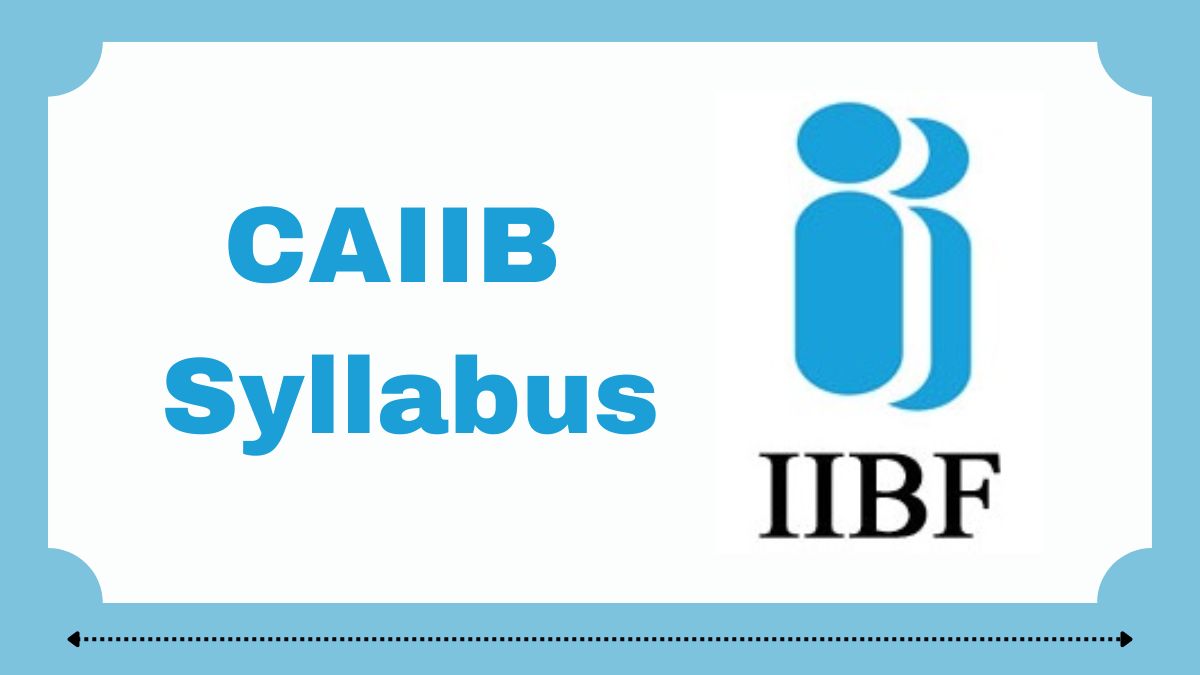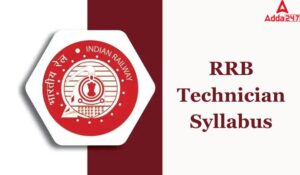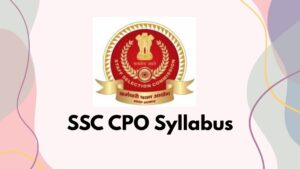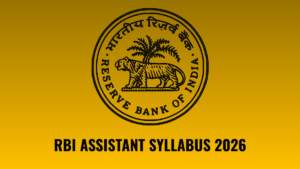Table of Contents
Appearing for the CAIIB Exam and do not know where to start? Then you are at the right place. CAIIB is conducted twice a year, and IIBF has provided the official CAIIB Syllabus along with guidelines on the number of attempts and minimum qualifying marks required to qualify for the exam. The CAIIB Syllabus and Exam Pattern 2025 is designed to enhance the professional knowledge of banking employees and officers. It covers advanced concepts of banking, finance, management, banking regulations & business, helping candidates gain expertise beyond the basics. Let’s check the syllabus in detail below.
CAIIB Syllabus 2025
Candidates who wish to progress their careers in the banking and finance sector must qualify in this exam. The CAIIB 2025 Exam consists of 4 compulsory and 1 Elective paper. Each paper is of 100 marks, carrying 100 questions in multiple-choice format. There is no negative marking for incorrect answers, so candidates can answer freely. Check the names of all CAIIB Papers below.
Compulsory Paper
- Paper 1: Advanced Bank Management(ABM)
- Paper 2: Bank Financial Management(BFM)
- Paper 3: Advanced Business and Financial Management (ABFM)
- Paper 4: Banking Regulations and Business Laws (BRBL)
Elective Paper
- Rural Banking
- Human Resources Management
- Risk Management
- Central Banking
- Information Technology and Digital Banking
CAIIB Exam Date 2025 Out- Click to Check
CAIIB Syllabus and Exam Pattern Highlights
Check the major highlights of the CAIIB Exam Pattern and syllabus below:
| Particulars | Details |
| Exam Conducting Body |
Indian Institute of Banking & Finance (IIBF)
|
| Papers |
4 Compulsory + 1 Elective
|
| Mode of Exam |
Online (Computer-Based Test)
|
| Type of Questions |
Multiple Choice Questions (MCQs)
|
| Total Questions | 100 per paper |
| Marks |
100 marks per paper
|
| Duration |
2 hours per paper
|
| Negative Marking | none |
CAIIB Exam Pattern 2025
It is important for the candidates to get familiar with the CAIIB Exam Pattern 2025 as it is the complete structure of the examination. It includes the marking scheme, subjects, number of questions, and marks. There are 100 questions and 100 marks in each subject which the candidates need to answer.
| CAIIB Exam Pattern 2025 | |||
| Subjects | No. of Questions | Marks | Duration |
| Advanced Bank Management(ABM) | 100 | 100 | 2 hour |
| Bank Financial Management (BFM) | 100 | 100 | 2 hour |
| Advanced Business and Financial (ABFM) Management | 100 | 100 | 2 hour |
| Banking Regulations and Business Laws (BRBL) | 100 | 100 | 2 hour |
| Elective Paper (Any One) | 100 | 100 | 2 hour |
The questions that will be asked in the examination will be related to the following points.
- Knowledge testing
- Problem-solving
- Conceptual grasp
- Case analysis
- Analytical/ logical exposition
CAIIB Syllabus 2025 for Compulsory Papers
There are two papers under the Compulsory Paper section, and the details of the CAIIB Syllabus 2025 are provided in the points below.
CAIIB Paper 1: Advanced Bank Management(ABM)
There are 4 modules in paper 1 (Advanced Bank Management ), given below:
- Module A: Statics
- Module B: Human Resource Management
- Module C: Credit Management
- Module D: Compliance in Banks & Corporate Governance
Module A: Statistics
The topics included in the Module A has been mentioned in the table mentioned in the table given below.
| Advanced Bank Management(ABM): Module A | |
| Topics | Sub-Topics |
| Definition of Statistics, Importance & Limitations & Data Collection, Classification & Tabulation |
|
| Sampling Techniques |
|
| Measures of Central Tendency & Dispersion, Skewness, Kurtosis |
|
| Correlation and Regression |
|
| Time Series |
|
| Theory of Probability |
|
| Estimation |
|
| Linear Programming |
|
| Simulation |
|
Module B: Human Resource Management
The details of the Human Resource Management have been mentioned below for the candidates.
| Advanced Bank Management(ABM): Module B |
|
| Topics | Sub-Topics |
| Fundamentals of Human Resource Management |
|
| Development of Human Resources |
|
| Human Implications of Organizations |
|
| Employee Feedback and Reward System |
|
| Performance Management |
|
| Conflict Management and Negotiation |
|
| HRM and Information Technology |
|
Module C: Credit Management
The details of the topics and subtopics for credit management have been given in the table below.
| Topics | Sub-Topics |
| Overview of Credit Management |
|
| Analysis of Financial Statements |
|
| Working Capital Finance |
|
| Term Loans |
|
| Credit Control and Monitoring |
|
| Risk Management and Credit Rating |
|
| Restructuring/Rehabilitation and Recovery |
|
| Resolution of Stressed Assets under Insolvency and Bankruptcy Code 2016 |
|
Module D: Compliance in Banks & Corporate Governance
The topics and subtopics for compliance in Banks and Corporate Governance have been mentioned in the table given below.
| Topics | Sub-Topics |
| Compliance Function in Banks |
Compliance Policy; Compliance Principles
Process and Procedures Compliance Programme Scope of Compliance Function Role & Responsibilities of Chief Compliance Officer (CCO) |
| Compliance Audit |
Role of Risk-Based Internal Audit and Inspection
Reporting Framework and Monitoring Compliance Disclosure Requirements Accounting Standards Disclosures under Listing Regulations of SEBI |
| Compliance Governance Structure |
Organisational Structure
Responsibility of the Board and Senior Management Compliance Structure at the Corporate Office Functional Departments Compliance Structure at Field Levels Internal Controls and Their Importance Framework for Identification of Compliance Issues and Compliance Risks Compliance Issues Compliance Risk Inherent Risk and Control Risk Independent Testing and Effective Audit Programme Reporting Framework and Monitoring Compliance Role of Inspection and Audit Loan Review Mechanism/Credit Audit |
| Compliance Culture and GRC Framework |
How to Create a Compliance Culture Across the Organisation
Governance, Risk and Compliance (GRC) Framework Benefits of an Integrated GRC Approach Whistleblower Policy The Components of a Whistleblower Policy Reasons for Compliance Failures |
| Compliance Function and Role of CCO in NBFCs |
Framework for Scale-Based Regulation for Non-Banking Financial Companies
Transition Path: Framework for Compliance Function and Role of Chief Compliance Officer in Non-Banking Financial Companies in Upper Layer and Middle Layer (NBFCUL & NBFCML) |
| Fraud and Vigilance in Banks |
Definition of Fraud
Definition of Forgery Areas in which Frauds are committed in Banks Banking and Cyber Frauds Fraud Reporting and Monitoring System Vigilance Function in Banks RBI Guidelines for Private Sector and Foreign Banks |
Paper 2: Bank Financial Management (BFM)
Paper 2 include International Banking, Risk Management, Treasury Management, and Balance Sheet Management. Check the module-wise topics below:
Module A: International Banking
| Unit | Topics Covered |
| Exchange Rates and Forex Business |
• Foreign Exchange – Definition and Markets
• Factors Determining Exchange Rates • Exchange Rate Mechanism • Foreign Exchange Dealing Room Operations • Derivative Products • RBI / FEDAI Guidelines • Foreign Exchange Arithmetic – Concepts & Examples |
| Liberalized Remittance Scheme (LRS) and Other Remittances |
• Capital Account & Current Account Transactions
• FEMA Sections & LRS • Permissible/Non-permissible Remittances • Operational Guidelines • LRS for Current Account Transactions • Tax Collected at Source (TCS) • LRS & Capital Account Transactions • Reporting Requirements |
| Correspondent Banking & NRI Accounts |
• Correspondent Banking – Accounts & Services
• Nostro, Vostro, and Loro Accounts • Electronic Payment Modes – SWIFT, CHIPS, CHAPS, RTGS • NRI Banking – Rupee & Foreign Currency Accounts • Facilities for NRIs • Advances against Deposits • Housing Loans to NRIs |
| Documentary Letters of Credit |
• Definition & Types of LCs
• UCP 600 & Key Articles • Rights & Liabilities of Parties • Documents under LC – Scrutiny, Crystallization, Follow-up • Risks in LC Transactions • Standby LC & URR–725 • ISBP 745 • Incoterms • Export-Import Facilities & Guidelines (EDPMS, IDPMS) • Export/Import Finance, Trade Credit, Factoring & Forfaiting • Case Studies on Export Finance |
| External Commercial Borrowings & Foreign Investments |
• ECB Concepts & Reporting Requirements
• Conversion of ECB into Equity • Foreign Investments – Key Concepts • Eligible Investors, Entities, and Instruments • Prohibited Sectors • Rules on Pledge of Shares • NDI Rules Snapshot • Documentation for Investments & Refunds |
| Risks in Foreign Trade & Role of ECGC |
• Risks in International Trade
• Country Risk • Export Credit Insurance & ECGC Products • ECGC Policies for Banks • “To Do Points” under ECGC • Role of EXIM Bank & RBI • FEMA 1999, FEDAI Rules |
| Short Notes on Other Topics |
• ECB, ADR/GDRs, FCCBs
• IFSC & GIFT City – Scope, Opportunities, IBUs • Role of IFSCA & Regulatory Framework • Relaxations for FPIs • Technology in International Banking • Digitization & FINTECH Evolution • Blockchain in International Trade • Challenges in FINTECH |
Module B: Risk Management
| Unit | Topics Covered |
| Risk and Basic Risk Management Framework |
• What is Risk?
• Linkages among Risk, Capital, and Return • Why Risk Management? • Basic Risk Management Framework |
| Risks in the Banking Business |
• Risk Identification in Banking Business
• The Banking Book • The Trading Book • Off-Balance Sheet Exposures • Banking Risks – Definitions |
| Risk Regulations in the Banking Industry |
• Necessity & Goals of Regulation
• Risk-based Regulation in a Changing Environment • Basel I – The Basel Capital Accord • 1996 Amendment for Market Risk • Basel II – Need, Goals, and Framework • Transition to Basel III • Capital Charge for Credit, Market & Operational Risks • Pillar 2 – Supervisory Review • Pillar 3 – Market Discipline • Capital Conservation Buffer • Leverage Ratio • Countercyclical Capital Buffer • Systemically Important Financial Institutions (SIFIs) • Risk-Based Supervision (RBS) |
| Market Risk |
• Concept of Market Risk
• Market Risk in Banks • Market Risk Management Framework • Organisation Structure • Risk Identification, Measurement & Monitoring • Risk Control & Reporting • Managing Trading Liquidity • Risk Mitigation |
| Credit Risk |
• General Overview
• Credit Risk Management Framework • Organisation Structure • Risk Identification, Measurement & Monitoring • Transaction-level Guidelines & Portfolio-level Controls • Active Credit Portfolio Management • Loan Review Mechanism (LRM) • Credit Risk Mitigation • Securitisation |
| Credit Derivatives, Operational Risk & Integrated Risk Management |
• Credit Derivatives (CDs)
• Operational Risk – General & Classification • Operational Risk by Event Type – Definitions • Operational Risk Management Practices • Processes & Framework • Risk Monitoring & Mitigation • Scenario Analysis • Integrated Risk Management – Necessity, Challenges & Approach |
| Liquidity Risk Management |
• Importance of Liquidity Risk Management
• Liquidity Risk Drivers & Types • Principles of Sound Liquidity Risk Management • Governance, Policies & Strategies • Ratios for Liquidity Risk • Stress Testing & Contingency Funding Plans • Overseas Operations – Indian & Foreign Banks • Liquidity Across Currencies • MIS & RBI Reporting • Internal Controls |
| Basel III Liquidity Standards |
• Liquidity Coverage Ratio (LCR)
• Liquidity Risk Monitoring Tools • Net Stable Funding Ratio (NSFR) |
Module C: Treasury Management
| Unit | Topics Covered |
| Introduction to Treasury Management |
• Concept & Functions of Integrated Treasury
• Process of Globalisation • Treasury as a Profit Centre • Organisation of Treasury |
| Treasury Products |
• Products of Foreign Exchange Markets
• Money Market Products • Securities Market Products • Domestic and Global Markets |
| International Equity & Debt Products |
• Regulatory Environment
• Global Depository Receipts (GDRs) • Indian Depository Receipts (IDRs) • External Commercial Borrowings (ECBs) • Trade Credits |
| Rupee-Denominated Bonds, Funding & Regulatory Aspects |
• Reserve Assets – CRR & SLR
• Liquidity Adjustment Facility (LAF) • Payment and Settlement Systems |
| Treasury Risk Management |
• Supervision & Control of Treasury
• Market Risk • Credit Risk |
| Risk Measures |
• Value at Risk (VaR)
• Duration • Derivatives in Risk Management |
| Derivative Products |
• Derivatives & Treasury
• OTC vs Exchange-Traded Products • Forwards, Options, Futures & Swaps • Interest Rate & Currency Swaps • Indian Market Developments & RBI Guidelines on Risk Exposure |
| Treasury & Asset-Liability Management (ALM) |
• Meaning of ALM
• Liquidity Risk & Interest Rate Risk • Role of Treasury in ALM • Use of Derivatives in ALM • Credit Risks & Credit Derivatives • Transfer Pricing • Policy Environment |
Module D: Balance Sheet Management
| Unit | Topics Covered |
|---|---|
| Components of Assets & Liabilities in a Bank’s Balance Sheet and Their Management | • Components of a Bank’s Balance Sheet • What is Asset Liability Management (ALM)? • Significance of ALM • Purpose & Objectives of ALM • ALM as Coordinated Balance Sheet Management |
| Banking Regulation & Capital | • Capital and Banking Regulation • Capital Adequacy – Basel Norms • Scope of Application • Pillar 1 – Minimum Capital Requirements • Pillar 2 – Supervisory Review Process • Pillar 3 – Market Discipline |
| Asset Classification & Provisioning Norms | • Asset Classification • Provisioning Norms |
| Liquidity Management | • Definition of Liquidity Management • Dimensions & Role of Liquidity Risk Management • Measuring and Managing Liquidity Risk |
| Interest Rate Risk Management | • Essentials of Interest Rate Risk • Sources of Interest Rate Risk • Effects of Interest Rate Risk • Measurement Techniques for Interest Rate Risk • Strategies for Controlling Interest Rate Risk • Controls & Supervision • Sound Practices for Interest Rate Risk Management • RBI Draft Guidelines on Interest Rate Risk in Banking Book |
| RAROC & Profit Planning | • Profit Planning • Risk Aggregation & Capital Allocation • Economic Capital & RAROC |
Paper 3 Advanced Business and Financial Management (ABFM)
Module A: The Management Process
| Unit | Topics Covered |
|---|---|
| Basics of Management | • Definition of Management • The Management Process • Functions of Management • Importance of Management • Management Thoughts & Approaches • Management Challenges & Opportunities • Introduction to Strategic Management • Business Environment Analysis |
| Planning | • Fundamentals of Planning • Steps in Planning • Importance of Planning • Advantages & Disadvantages of Planning • Management by Objectives (MBO) • Plan Components • Contingency Planning • Forecasting & Decision Making |
| Organizing | • Introduction & Fundamentals of Organizing • Importance of Organisation • Stages in Organising Process • The Organising Process • Principles of Organizing • Types of Organisations • Organisation Structure • Organisation Charts & Manuals • Organisation Culture • Authority & Responsibility • Key Issues in Organisation Structure • Organisational Change • Conflict Dynamics |
| Staffing | • Functions of Staffing • Objectives & Nature of Staffing • Facets & Significance of Staffing • System Approach to Staffing • Recruitment, Selection, Training, Retention & Development • Knowledge & Learning Management • Performance Appraisal • Human Resource Development (HRD) |
| Directing | • Characteristics of Directing • Importance of Directing • Elements of Directing • Leadership • Motivation • Communication • Supervision |
| Controlling | • Basics & Characteristics of Controlling • Advantages & Limitations of Controlling • Types of Control Management • Control Process • Relation between Planning & Control • Control Techniques • Control Techniques & Information Technology |
Module B: Advanced Concepts Of Financial Management
| Unit | Topics Covered |
|---|---|
| Sources of Finance | • Equity Capital • Internal Accruals • Preference Capital • Term Loans • Debentures • Alternative Financing Strategies in the Context of Regulatory Requirements |
| Financial and Operating Leverages | • Financial Leverage • Degree of Financial Leverage & its Behaviour • Operating Leverage • Degree of Operating Leverage & its Behaviour • Combined / Total Leverage |
| Capital Investment Decisions | • Objectives of Capital Investment Decisions • Estimation of Project Cash Flows • Forecasting & Regulation of Capital (Short, Medium, Long Term) • Relationship: Sales, Production & Functional Budgets • Cash Forecasts • Cost Analysis for Projects • Methods of Investment Appraisal • Social Cost-Benefit Analysis |
| Capital Budgeting for International Project Investment | • Foreign Investment Analysis • Foreign & Home Currency Cash Flows • Foreign Currency Discount Rates Computation • International Portfolio Investment & Institutional Constraints • Direct & Indirect Channels for Portfolio Investment • Exchange & Country Risk • Return & Risk of Foreign Investment • CAPM (Capital Asset Pricing Model) • Arbitrage Pricing Theory • International Capital Budgeting Issues • Approaches for Overseas Project Evaluation • Evaluation Methods • Impact of Transfer Pricing |
| Adjustment of Risk & Uncertainty in Capital Budgeting | • Sources & Perspectives on Risk • Sensitivity Analysis • Scenario Analysis • Hillier Model • Simulation Analysis • Decision Tree Analysis • Corporate Risk Analysis • Managing Risk • Project Selection under Risk • Risk Analysis in Practice |
| Decision Making | • Cost-Volume-Profit (CVP) Analysis • Relevant Cost Concepts in Decision Making • Activity-Based Costing (ABC) • Ethical & Non-Financial Considerations |
Module C: Valuation, Mergers & Acquisitions
| Unit | Topics Covered |
|---|---|
| Approaches to Corporate Valuation | • Adjusted Book Value Approach • Stock and Debt Approach • Direct Comparison Approach • Discounted Cash Flow (DCF) Approach • Steps in DCF Valuation |
| Discounted Cash Flow (DCF) Valuation | • Estimating Inputs • Approaches to DCF Models • Different DCF Models • Dividend Discount Model (DDM) • Applicability of DDM |
| Other Non-DCF Valuation Models | • Relative Valuation Model • Equity Valuation Multiples • Enterprise Value Multiples • Choosing the Right Multiples • Book Value Approach • Stock and Debt Approach |
| Special Cases of Valuation | • Intangibles (Brand, Human Valuation, etc.) • Real Estate Firms • Start-up Firms • Firms with Negative/Low Earnings • Financial Service Companies • Distressed Firms • Valuation of Cash & Cross Holdings • Warrants & Convertibles • Cyclical & Non-Cyclical Companies • Holding Companies • E-commerce Firms |
| Mergers, Acquisitions & Restructuring | • Types of Transactions • Reasons for Merger • Mechanics of a Merger • Costs & Benefits of Merger • Exchange Ratio • Purchase of Division/Plant • Takeovers • Leveraged Buyouts (LBOs) • Acquisition Financing • Business Alliances • Managing Acquisitions • Divestitures • Holding Companies • Demergers |
| Deal Structuring & Financial Strategies | • Negotiations • Payment & Legal Considerations • Tax & Accounting Considerations • Tax Reliefs & Benefits in Amalgamation (India) • Financial Reporting of Business Combinations • Deal Financing • Financing of Cross-Border Acquisitions (India) |
Module D: Emerging Business Solutions
| Unit | Topics Covered |
|---|---|
| Hybrid Securities | • Advantages & Disadvantages of Hybrid Securities • Types of Hybrid Securities • Preference Share Capital • Features of Warrants • Features of Convertible Debentures • Differences: Warrants vs. Convertible Debentures • Valuation of Warrants • Valuation of Compulsorily Convertible Debentures (Partly/Fully) • Objectives of Issuing Warrants & Convertible Debentures • Features of Foreign Currency Convertible Bonds (FCCBs) |
| Mezzanine Financing, Innovative Hybrids & Start-up Finance | • Benefits to Startups under Startup Plan • Startup Definition in India • Challenges Faced by Startups • State Startup Policy • Pitch Presentation • Startup Programs & Competitions • Tax Exemptions • Funding Schemes & Programmes • Investor’s Outlook in Startups • International Challenges & Bridges |
| Private Equity & Venture Capital | • Characteristics of Venture Capital Investments • Private Equity vs. Venture Capital – Similarities & Distinctions • Financing Options via Venture Capital • Investment in Private Equity • Benefits of Private Equity • Drawbacks of Private Equity • Due Diligence • Exit Strategies |
| Artificial Intelligence (AI) | • History of AI • Applicability of AI • AI in Banking & Finance • Future Scope of AI • Neural Networks • Control Theory & Cybernetics • Rational Agents • Motion & Manipulation • Tools & Techniques of AI • AI & Morality |
| Business Analytics as a Management Tool | • Essentials of Business Analytics • Types of Analytics • Elements of Business Analytics • Big Data Analytics • Web & Mobile Analytics • Web vs. Mobile Analytics (Comparison) • Importance of Business Analytics |
| Green & Sustainable Financing | • ISO Standards for Green Finance • Building Green Finance • International Best Practices • Public Policy in India • Progress of Green Finance in India • Challenges & Way Forward • Growth of Regulatory Framework • National Efforts towards Green & Sustainable Financing • RBI’s Views on Climate Risk & Sustainable Finance |
| Special Purpose Acquisition Company (SPAC) | • Advantages of SPAC • Disadvantages of SPAC • SPAC Formation & Timelines • SPAC Merger • Key Stakeholders • Characteristics of SPACs • Process & Capital Structure • Trust Account • Warrants & Forward Purchase • IPO Agreements • De-SPAC Process |
Paper 4: Banking Regulations and Business Laws (BRBL)
Module A: Regulations and Compliance
| Unit | Topics Covered |
|---|---|
| Legal Framework of Banking Regulation | • Business of Banking • Constitution of Banks • Reserve Bank of India Act, 1934 • Banking Regulation Act, 1949 • RBI as Central Bank & Regulator of Banks/NBFCs • Government as Regulator of Banks • Control over Co-operative Banks • Regulation by Other Authorities |
| Control over Organisation of Banks | • Licensing of Banking Companies • RBI Licensing Policy – Universal Banks & Small Finance Banks • Branch Licensing • Paid-up Capital & Reserves • Shareholding in Banking Companies • Subsidiaries of Banking Companies • Board of Directors • Chairman of Banking Company • Appointment of Additional Directors • Restrictions on Employment • Controls over Management • Corporate Governance • Directors & Corporate Governance |
| Regulation of Banking Business | • RBI’s Power to Issue Directions • Acceptance of Deposits • Nomination Rules • Loans & Advances • Regulation of Interest Rates • Payment Systems Regulation • Internet Banking Guidelines • Regulation of Money Market Instruments • Banking Ombudsman • Regulation to Strengthen Financial Stability • Returns & Inspection • Winding Up of Banks • Mergers & Acquisitions • Annual Accounts & Balance Sheet • Audit & Auditors • Submission of Returns • Preservation of Records & Paid Instruments • Special Audit, Inspection & Scrutiny • Board for Financial Supervision • Acquisition & Amalgamation of Banks • Penalties for Offences |
| Types of Banks & Application of Regulations | • Public Sector Banks • Private Sector Banks • Regional Rural Banks (RRBs) • Differentiated Banks • Co-operative Banks • Local Area Banks • State Bank of India • Application of Banking Regulation Act to Public Sector Banks • Disinvestment of Shares by Government |
| Non-Banking Financial Companies (NBFCs) | • Regulators of NBFCs • Role of NBFCs in Inclusive Growth • Registration Process • Scale-Based Regulatory Structure • Nomenclature & Regulatory Norms • Capital Guidelines • Prudential Guidelines • Corporate Governance in NBFCs • Fair Practices Code • Bank Finance to NBFCs (Registered/Unregistered) • Co-lending by Banks & NBFCs to PSA |
| Financial Sector Reforms & Oversight | • Financial Sector Legislative Reforms • Narasimham Committees I & II • Banking Sector Reforms • Reforms in Monetary Policy • Reforms in Financial Markets • Reforms in Forex Market • Financial Stability and Development Council (FSDC) • Functions of FSDC • Wings of FSDC |
Module B: Important Acts/Laws & Legal Aspects of Banking Operations –Part A
| Act / Law | Key Topics Covered |
|---|---|
| The Prevention of Money Laundering Act, 2002 (PMLA) | • Offence of Money Laundering • Punishment for Money Laundering • Obligations of Banking Companies, Financial Institutions & Intermediaries • Enhanced Due Diligence • Rules Framed under PMLA • Records to be Maintained • Information contained in Records • Procedure for Maintaining Information • Procedure for Furnishing Information to the Director (FIU) • Verification of Client Identity (KYC Norms) • Maintenance of Client Identity Records • Case Studies on PMLA |
| Negotiable Instruments Act, 1881 | • Meaning, Types & Characteristics of Negotiable Instruments • Drawer / Acceptor • Payment of Cheques – Protection to Bankers/Customers • Material Alteration & Effects • Alteration not apparent – Legal Implications • Protection to Collecting Banker |
| Foreign Exchange Management Act, 1999 (FEMA) | • Important Terms under FEMA • Regulation & Management of Foreign Exchange • Powers of RBI regarding Authorized Persons • Contravention, Penalties, Adjudication & Appeals • Directorate of Enforcement • Special Provisions Relating to Assets held Outside India |
| Payment & Settlement Systems Act, 2007 | • Key Definitions • Designated Authority & Authorization • Regulation & Supervision by RBI • Settlement & Netting Provisions • RBI’s Power to Frame Regulations |
| Law Relating to Securities & Modes of Charge – I | • Mortgage • Document of Title to Immovable Property – Meaning • Acceptability of Copy of Title Documents |
| Law Relating to Securities & Modes of Charge – II | • Appropriation • Assignment • Pledge • Hypothecation • Banker’s Lien & Right of Set-off • Creation / Registration / Satisfaction of Charges • Meaning of Charge • Procedure for Registration of Charge • Effect of Registration & Non-Registration of Charges • Companies Act 2013 – Provisions on Charge Registration |
Module C: Important Acts/Laws & Legal Aspects of Banking Operations
| Act / Scheme | Key Topics / Coverage Areas |
|---|---|
| Reserve Bank – Integrated Ombudsman Scheme, 2021 | • Coverage and Definitions • Ombudsman – Appointment / Location of Offices / Centralized Receipt & Processing Centre • Procedure for Redressal of Grievances • Filing a Complaint – Initial Scrutiny & Resolution • Passing of an Award & Right to Appeal • Suspension of the Scheme |
| Micro, Small and Medium Enterprises Development Act, 2006 | • Coverage and Definitions • Summary of Regulation • NBMSME & Advisory Committee • Memorandum of MSMEs • Delayed Payments to MSEs • MSE Facilitation Council & Dispute Reference • Disclosures & Penalty for Contravention |
| SARFAESI Act, 2002 | Constitutional Validity • Key Definitions: Asset Reconstruction, Borrower, Secured Asset, Security Interest, NPA, Security Receipt, Sponsor etc. Regulation of Securitisation & Reconstruction: Registration of ARC, Acquisition of Financial Assets, Issue of Security Receipts, Measures of Asset Reconstruction, RBI Powers Enforcement of Security Interest: Magistrate’s Assistance, Takeover of Management, No Compensation to Directors, Borrower’s Right to Appeal & Compensation Central Registry: Registration & Rectification of Security Interests, Filing of Transactions, Inspection Rights Offences & Penalties: Penalties for Non-compliance, Cognizance of Offences, Appeals Miscellaneous: Non-Applicability in Certain Cases, Good Faith Protection, Overriding Effect, Rule Making Registration of Security Interest by Creditors: Priority of Secured Creditors, Effect of Registration |
| Recovery of Debts and Bankruptcy Act, 1993 (RDB Act) | Constitutional Validity & Definitions • Establishment of DRTs & Appellate Tribunals (Composition, Appointment, Qualification, Tenure) • Jurisdiction, Powers & Authority of Tribunals (Exclusion of Civil Courts) • Procedure: Application to Tribunal, Appeals, Deposit for Appeals, Limitation • Recovery of Debts: Recovery Certificates, Stay, Application of Income Tax provisions, Appeal against Recovery Officer • Miscellaneous: Transfer of Pending Cases, Public Servants, Good Faith Protection, Rule Making |
| Insolvency and Bankruptcy Code (IBC), 2016 | • Definitions, Coverage, Pillars of IBC • Insolvency Resolution Process for Companies & LLPs • CIRP Initiation by Financial Creditor, Suspension of CIRP, Ineligible Persons • Time Limit for CIRP & Withdrawal of Application • Declaration of Moratorium, Public Announcement, IRP Appointment • Committee of Creditors, Resolution Professional • Liquidation & Priority of Debt Repayment • Fast Track Insolvency, Voluntary Liquidation |
| Bankers’ Books Evidence Act, 1891 | • Applicability and Definitions • Conditions in Printout • Proof of Entries in Bankers’ Books • Non-compellable Cases for Bank Officers • Court-ordered Inspection • Cost of Applications |
| Legal Services Authorities Act, 1987 – Lok Adalats | • Organisation & Jurisdiction of Lok Adalats • Cognizance of Cases • Case Disposal Process • Nature of Awards • Powers of Lok Adalats |
| Consumer Protection Act, 2019 | • Definitions • Unfair Contracts & Trade Practices • Consumer Protection Councils – Central, State, District • Central Consumer Protection Authority • Consumer Disputes Redressal Commissions (District, State, National) • Consumer Mediation Cell • Finality of Orders & Limitation Period |
| Law of Limitation | • Definitions • Limitation & Its Computation • Fresh Period of Limitation • Key Provisions in Schedule |
| Tax Laws | • Income Tax • Commodity Transaction Tax • Goods and Services Tax (GST) |
CAIIB Elective Paper 1: Rural Banking
| Subject Name | Topics |
| Module – A: Rural India | |
| Demographic feature |
|
| Characteristics of Rural Society |
|
| Rural infrastructure |
|
| Rural Issues |
|
| Module – B: Financing Rural Development | |
| Regulation of Rural Financial Services |
|
| Rural Credit Institutions |
|
| Financing agriculture/ allied activities |
|
| Financing Rural Non-Farm Sector (RNFS) |
|
| SME Finance |
|
| Module – C: Priority Sector Financing and Government Initiatives | |
| – |
|
| Government initiatives |
|
| Module – D: Problems and prospects in Rural Banking | |
| Role of rural banking |
|
CAIIB Elective Paper 2: International Banking
| Chapters | Topics |
| Module – A: International Banking and Finance | |
| International Banking |
|
| International Finance |
|
| Module – B: Foreign Exchange Business | |
| – |
|
| Module – C: International Trade | |
| Regulations covering international trade |
|
| Import/ Export Finance |
|
| Module – D: Derivatives | |
| – |
|
CAIIB Elective Paper 3: Information Technology
| Chapters | Topics |
| Module – A: Introduction to Information Technology | |
| Impact of IT on Banking |
|
| System Software |
|
| Computer Languages |
|
| Application Software |
|
| Computer Networks |
|
| Module – B: Systems and Design | |
| Systems and Design |
|
| MIS and Organization Support Systems |
|
| Module – C: Applications in Banking | |
| Applications in Banking |
|
| E-Commerce |
|
| Module – D: Security, Controls, and Guidelines | |
| Threats to Information System |
|
| IT Service Delivery & Support |
|
CAIIB Elective Paper 4: Risk Management
| Chapters | Topics |
| Module – A: An overview | |
| Risk definition/ policies |
|
| Asset Liability Management |
|
| Risk measurement & Control |
|
| Risk management |
|
| Module – B: Credit Risk Management | |
| Credit Risk Management |
|
| Module – C: Operational Risk | |
| Operational Risk |
|
| Module – D: Market Risk | |
| Market Risk |
|
| Treatment of market risk under Basel |
|
| Module – E: Risk Organization and Policy | |
| Risk Organization and Policy |
|
CAIIB Elective Paper 5: Central Banking
| Chapters | Topics |
| Module – A: Rationale and Functions of Central Bank | |
| Evolution and Functions of Central Banking |
|
| Functions of a Central Bank |
|
| Contemporary Issues |
|
| Module – B: Central banking in India | |
| Reserve Bank of India |
|
| India Specific Issues: |
|
| Module – C: Monetary Policy and Credit Policy | |
| Monetary Policy |
|
| Credit Policy |
|
| An overview of Fiscal Policy |
|
| Module – D: Supervision and Financial Stability | |
| Indian Financial System |
|
| Financial Stability |
|
| Important links: | |
| CAIIB Previous Year Papers | CAIIB Registration 2025 |
| CAIIB Online Coaching 2025 | |



 RRB Technician Syllabus 2025 and Exam Pa...
RRB Technician Syllabus 2025 and Exam Pa...
 SSC CPO Syllabus 2025, Tier 1 and 2 Mark...
SSC CPO Syllabus 2025, Tier 1 and 2 Mark...
 RBI Assistant Syllabus 2026 and Exam Pat...
RBI Assistant Syllabus 2026 and Exam Pat...









